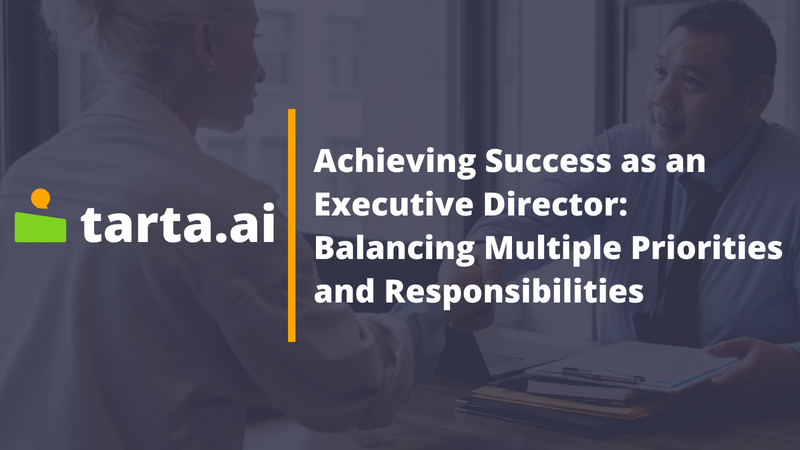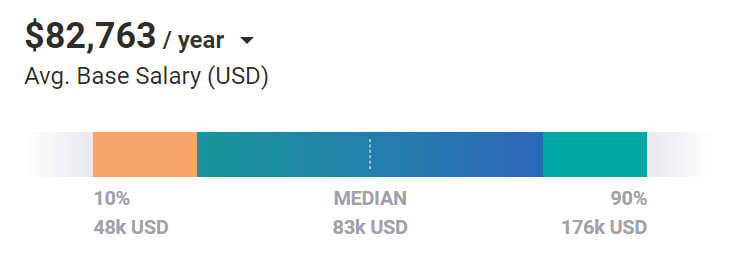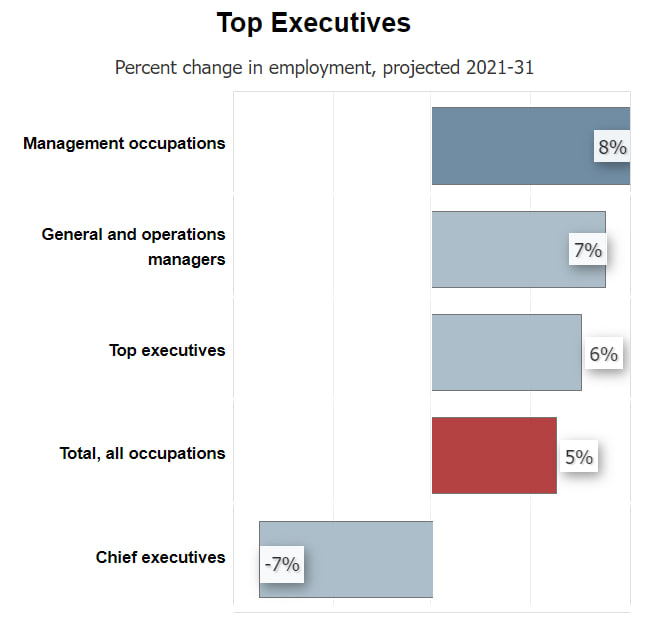Achieving Success as an Executive Director: Balancing Multiple Priorities and Responsibilities

In today's society, there is an increasing demand for skilled leaders who can effectively manage organizations and drive them towards success. As such, the role of an Executive Director has become crucial for both non-profit organizations and companies. An Executive Director is responsible for the overall management and direction of an organization, ensuring that it achieves its goals and objectives.
This article provides an in-depth overview of the qualifications, responsibilities, earnings, work environment, education and training, career options, job outlook, and potential advantages and disadvantages of working as an Executive Director. By understanding these factors, individuals considering a career as an Executive Director can gain valuable insights into the requirements and challenges of this position and make an informed decision.
Position Overview
An Executive Director is the highest-ranking officer in a non-profit organization or a company. They are responsible for the overall management and direction of the organization, ensuring that it achieves its goals and objectives. The Executive Director typically reports to a Board of Directors or a similar governing body, and is responsible for implementing the policies and strategies developed by the board.

Key Qualifications
The key qualifications for an Executive Director vary depending on the organization and industry, but generally include:
- Leadership skills: Being a strong leader who can inspire and motivate staff and stakeholders, set a vision for the organization, and make tough decisions when necessary.
- Strategic thinking: Being able to develop and implement long-term strategic plans that align with the organization's mission and goals.
- Financial management skills: Having a solid understanding of financial management and being able to manage budgets, financial reporting, and fundraising efforts.
- Communication skills: Having excellent written and verbal communication skills, as Executive Directors will be responsible for representing the organization to a wide range of stakeholders.
- Experience in the relevant industry or field: Having relevant experience in the industry or field in which the organization operates.
- Strong networking skills: Having a strong network of contacts and being able to cultivate relationships with potential funders, partners, and stakeholders.
- A commitment to the organization's mission: Being deeply committed to the organization's mission and values, and having a strong sense of purpose in their work.
An Executive Director should have a combination of strategic, financial, and interpersonal skills, as well as a deep commitment to the organization's mission and goals.
Interesting fact:
In the non-profit sector, Executive Directors typically have a term of service that ranges from 2 to 10 years, after which they may be replaced or reappointed.
Tasks and Expectations
An Executive Director is the senior-most executive in an organization, responsible for overseeing the overall management and operations of the organization. The specific tasks and expectations of an Executive Director generally include:
- Developing and implementing the organization's strategic plan: Working with the board of directors and other senior leaders to develop a long-term strategic plan that outlines the organization's mission, goals, and objectives. Executive Directors must then ensure that the organization is implementing the plan effectively and making progress towards its goals.
- Managing staff and resources: Managing the organization's staff, including hiring, training, and performance management. Executive Directors must also oversee the organization's financial resources, including budgeting, fundraising, and ensuring compliance with financial regulations.
- Building and maintaining relationships: The Executive Director must build and maintain relationships with a variety of stakeholders, including the board of directors, staff, donors, partners, and the community. They must be able to effectively communicate the organization's mission and goals and build trust and credibility with stakeholders.
- Advocating for the organization: The Executive Director is the public face of the organization and must advocate for its mission and goals to the public, media, and other stakeholders. They must be able to effectively communicate the organization's message and build support for its work.
- Ensuring compliance with legal and regulatory requirements: Ensuring that the organization is in compliance with all legal and regulatory requirements, including tax and employment laws, and ensuring that the organization is conducting its operations ethically and transparently.
- Monitoring and evaluating organizational performance: The Executive Director must regularly monitor and evaluate the organization's performance against its goals and objectives. They must identify areas for improvement and implement strategies to address them.
- Continuously improving the organization: Seeking out opportunities to improve the organization's operations, programs, and services. Executive Directors must be innovative and creative in identifying new opportunities for growth and expansion.
Overall, the Executive Director is responsible for providing strategic leadership and vision for the organization and ensuring that it is operating effectively, efficiently, and in alignment with its mission and values.
Compensation
The salary of an Executive Director in the US can vary widely depending on the industry, organization size, location, and other factors. According to data from PayScale, the national average salary for an Executive Director in the United States is around $82,700 per year. However, this can range from around $48,000 to over $176,000 per year, depending on the specific circumstances of the position.

Source: PayScale
Strategies for Increasing Income
There are several ways an Executive Director can increase their earnings. Here are a few options:
Strategy | Description |
Negotiate a higher salary | The most straightforward way to increase earnings is to negotiate a higher salary. If you believe that your current salary is below the industry standard or not commensurate with your level of experience and responsibilities, you can make a case for a raise during salary negotiations. |
Look for opportunities to earn bonuses or profit-sharing | Many Executive Directors have opportunities to earn bonuses or profit-sharing based on the performance of their organization. This can be a significant source of additional income, so it's worth looking into whether your organization offers such incentives. |
Consider equity compensation | In some cases, Executive Directors may be offered equity compensation, such as stock options or restricted stock units, as part of their compensation package. This can provide an opportunity to earn additional income if the organization's stock performs well. |
Pursue additional education or certifications | Obtaining additional education or certifications can make you a more competitive candidate for higher-paying Executive Director positions. Consider pursuing an MBA or other advanced degree or obtaining certifications in areas such as nonprofit management or financial management. |
Consider freelance consulting or speaking engagements | Executive Directors with expertise in their field may be able to earn additional income by offering consulting services or speaking engagements on a freelance basis. This can be a great way to supplement your income while building your professional network. |
Interesting fact:
The number of women in Executive Director roles in the US has increased steadily in recent years, but they still only make up around 30% of the total.
Supplementary Perks
In addition to salary, Executive Directors may also receive additional benefits as part of their compensation package. Here are some common additional benefits:
- Health insurance: Many organizations offer health insurance as part of their benefits package, which can include medical, dental, and vision coverage for the Executive Director and their dependents.
- Retirement plans: Some organizations offer retirement plans, such as 401(k) or pension plans, that allow the Executive Director to save for their retirement.
- Vacation time and sick leave: Executive Directors may be entitled to paid vacation time and sick leave, which can vary depending on the organization's policies.
- Life and disability insurance: Some organizations offer life and disability insurance as part of their benefits package, which can provide financial protection in the event of an unforeseen accident or illness.
- Professional development opportunities: Many organizations provide opportunities for professional development, such as attending conferences or training programs, which can help the Executive Director develop new skills and advance their career.
- Flexible work arrangements: Some organizations offer flexible work arrangements, such as remote work or flexible hours, which can provide the Executive Director with a better work-life balance.
The specific benefits offered to an Executive Director can vary depending on the organization and industry, so it's important to carefully review the compensation package before accepting a position.
Work Environment
In this section, we will explore the work environment settings that can help Executive Directors be productive and efficient, while also maintaining their well-being and work-life balance. Additionally, we will look at the various tools and technologies that Executive Directors use to manage their responsibilities effectively.
By understanding the work environment settings and tools and technologies used by Executive Directors, we can gain insight into how they manage their responsibilities and make informed decisions, ultimately contributing to the success of their organizations.

Photo: Sora Shimazaki/Pexels
Work Environment Settings
As an Executive Director, the work environment settings that can help you maximize productivity and efficiency while also promoting well-being and work-life balance include:
- Private office: An Executive Director often requires a private office to work on confidential and sensitive matters. This provides a quiet and distraction-free space to concentrate on important tasks.
- Comfortable workspace: The workspace should be designed to be comfortable and ergonomic to reduce the risk of fatigue and injuries from long hours of sitting.
- Collaborative workspace: An Executive Director needs to work collaboratively with other members of the organization, including the board of directors and other senior staff. A collaborative workspace that includes conference rooms, meeting areas, and common spaces can facilitate this collaboration.
- Support staff: An Executive Director requires support staff, such as an administrative assistant, to handle routine tasks and ensure smooth operations, so they can focus on strategic and high-level tasks.
- Access to resources: An Executive Director should have access to resources, such as relevant data and information, research materials, and industry reports, to make informed decisions and stay up-to-date on trends and best practices.
- Comfortable break areas: An Executive Director should have access to comfortable break areas to relax and recharge during breaks and lunchtimes.
- Positive work culture: The work environment should foster a positive work culture, which includes clear communication, mutual respect, support, and recognition of accomplishments.
The work environment settings for Executive Directors should be tailored to their needs, responsibilities, and goals to ensure they can work productively and efficiently while maintaining their well-being and work-life balance.
Interesting fact:
Executive Directors often work long hours, with some putting in 60 or more hours per week, which can lead to burnout if not managed properly.
Tools and Technologies
Executive Directors use a variety of tools and technologies to help them manage their responsibilities and improve their productivity. Here are some common tools and technologies used by Executive Directors:
Tools and Technologies | Description |
Productivity software | This includes applications such as Microsoft Office, Google Workspace, and project management tools like Trello or Asana, which can help Executive Directors manage their schedules, communicate with staff and stakeholders, and keep track of ongoing projects. |
Customer Relationship Management (CRM) software | This type of software helps Executive Directors manage interactions with customers or clients, track sales and marketing efforts, and measure business performance. |
Financial management software | Financial management tools such as QuickBooks or Xero help Executive Directors track expenses, create invoices, and manage their organization's finances. |
Video conferencing and collaboration tools | Applications like Zoom, Skype, and Microsoft Teams allow Executive Directors to communicate remotely with staff and stakeholders, and collaborate in real-time on projects and presentations. |
Data analysis and reporting tools | This includes tools like Tableau or Google Analytics, which can help Executive Directors track business metrics, identify trends, and make data-driven decisions. |
Cybersecurity tools | Cybersecurity software like antivirus, firewalls, and encryption tools help Executive Directors protect sensitive data and prevent cyber attacks. |
Mobile devices | Mobile devices like smartphones and tablets enable Executive Directors to stay connected and access their work from anywhere, whether it be checking email or reviewing documents. |
Social media tools | Social media platforms such as Twitter, LinkedIn, and Facebook are often used by Executive Directors to connect with stakeholders, share updates, and promote their organization's mission. |
Executive Directors use a variety of tools and technologies to help them manage their responsibilities, improve productivity, and stay connected with stakeholders. The specific tools and technologies used depend on the organization's size, industry, and specific needs.
Education and Training
Education and training for Executive Directors typically involves a combination of formal education and on-the-job training. While there is no specific educational requirement for becoming an Executive Director, most organizations prefer candidates with a bachelor's or master's degree in business administration, public administration, or a related field.

Photo: Karolina Grabowska/Pexels
In addition to formal education, Executive Directors may benefit from attending training programs or workshops that focus on leadership, management, and communication skills. Many professional associations offer training and certification programs specifically designed for nonprofit executives.
On-the-job training is also critical for Executive Directors, as they must develop an understanding of their organization's culture, operations, and strategic goals. Executive Directors may work closely with other leaders within the organization, such as the board of directors or senior management team, to gain a deep understanding of the organization's structure and processes.
Mentoring can also be an effective way for Executive Directors to gain knowledge and skills from experienced leaders in their field. Some organizations may offer formal mentoring programs, while others may encourage informal mentoring relationships.
Overall, education and training for Executive Directors should focus on developing a well-rounded set of skills that includes strategic thinking, financial management, communication, and leadership. It is also important for Executive Directors to stay up-to-date with industry trends and best practices, which can be accomplished through continuing education programs and participation in professional associations.
Advancement Opportunities
This section is focused on providing information about various career options for individuals interested in pursuing a career as an Executive Director, as well as options for those looking to explore other career paths.

Photo: Andrea Piacquadio/Pexels
Career Ladder for Executive Directors
The career ladder for executive directors typically involves several stages of advancement, each with increasing levels of responsibility and leadership. Here is a possible career ladder for executive directors:
- Entry-Level Positions: At this stage, individuals typically start in entry-level positions such as program coordinator or project manager. These positions provide an opportunity to learn about the organization and its mission, as well as develop skills in areas such as program management, fundraising, and leadership.
- Mid-Level Positions: After gaining experience in entry-level positions, individuals can advance to mid-level positions such as director of programs or development. These positions typically involve more responsibility and leadership, such as managing staff and budgets, and working closely with the executive director to develop and implement strategic plans.
- Senior-Level Positions: As individuals gain more experience and demonstrate their leadership abilities, they can advance to senior-level positions such as chief operating officer or chief development officer. These positions typically involve overseeing multiple departments or programs and working closely with the executive director to lead the organization.
- Executive Director: Executive directors are responsible for the overall leadership and management of the organization, including developing and implementing strategic plans, overseeing staff and budgets, and building relationships with donors and community partners.
This career ladder is not necessarily linear and can vary depending on the size and structure of the organization.
Interesting fact:
The term "Executive Director" is used primarily in the nonprofit sector, while "CEO" is used more commonly in the for-profit sector.
Specializations for Executive Directors
There are various specializations that Executive Directors can pursue depending on their organization's mission, industry, and goals. Here are some examples of specializations for Executive Directors:
- Nonprofit Management: This specialization focuses on the unique challenges of leading and managing nonprofit organizations. It includes fundraising, grant writing, board governance, volunteer management, and program development.
- Healthcare Administration: This specialization focuses on the management and operations of healthcare organizations, including hospitals, clinics, and health systems. It includes healthcare policy, regulatory compliance, quality improvement, and financial management.
- Education Administration: This specialization focuses on the management and operations of educational institutions, including schools, colleges, and universities. It includes curriculum development, student services, academic affairs, and budgeting.
- Government Administration: This specialization focuses on the management and operations of government agencies at the local, state, or federal level. It includes public policy, budgeting, program evaluation, and community engagement.
- Corporate Social Responsibility: This specialization focuses on developing and implementing strategies that align a corporation's social and environmental responsibilities with its business goals. It includes sustainability, diversity and inclusion, and stakeholder engagement.
- International Development: This specialization focuses on managing and implementing programs that support economic and social development in low-income countries. It includes project management, partnerships and collaborations, and monitoring and evaluation.
These specializations are not exhaustive, and there may be other areas where Executive Directors can specialize depending on their organization's needs and goals. Nonetheless, these specializations provide a starting point for Executive Directors to explore their career paths.

Photo: Ono Kosuki/Pexels
Other Career Possibilities
There are many other career possibilities for Executive Directors. Here are some options:
Option | Description |
Marketing Manager | Marketing managers are responsible for developing and executing marketing strategies that promote a company's products or services. They work with various teams, such as advertising, sales, and creative, to ensure the company's messaging is consistent and effective. |
Human Resources Manager | Human resources managers oversee the administrative functions of an organization's human resources department. They manage employee benefits, recruitment and hiring, employee relations, and training and development programs. |
Financial Manager | Financial managers are responsible for overseeing an organization's financial health. They develop and monitor budgets, manage investments, and work with other teams to ensure financial compliance. |
IT Manager | IT managers are responsible for managing an organization's information technology systems. They oversee technology infrastructure, manage software and hardware updates, and ensure data security and privacy. |
Operations Manager | Operations managers oversee the day-to-day operations of an organization. They manage logistics, supply chain, production, and other operational functions to ensure efficiency and productivity. |
Entrepreneur | Entrepreneurs are individuals who start and manage their own businesses. They are responsible for identifying market opportunities, developing business plans, and securing funding for their ventures. |
These career options are just a few examples of the diverse range of career paths available. Individuals should consider their interests, skills, and career goals when exploring career options.
Employment Trends
In this section, we will explore the job outlook for Executive Directors and how it may be impacted by changes in the workplace, including the increasing popularity of flexible and remote work arrangements. We will examine how these trends are affecting the expectations and responsibilities of Executive Directors, as well as the opportunities and challenges that they may face in adapting to new work arrangements. Overall, this section will provide insights into the evolving landscape of Executive Director positions and the skills and competencies that will be most important for success in the coming years.
Executive Director Demand
The job outlook for Executive Directors varies depending on the industry and the specific organization. Overall, the Bureau of Labor Statistics (BLS) projects a 6% growth in employment for top executives, including Executive Directors, from 2021 to 2031, which is as fast as average for all occupations.

Source: U.S. Bureau of Labor Statistics, Employment Projections program
In addition, as organizations continue to navigate complex regulatory and financial environments, Executive Directors with strong leadership skills, strategic thinking abilities, and financial management expertise are likely to be in high demand. Executive Directors who can successfully adapt to changes in their industry, implement innovative solutions, and effectively manage teams will likely have the best job prospects.
Flexible and Remote Work Arrangements
Flexible and remote work arrangements have become increasingly common in recent years, and many organizations are now offering these options to their employees, including Executive Directors. However, the availability and extent of these arrangements can vary depending on the organization and industry.
In general, Executive Directors may have more flexibility in their work arrangements than other employees, as they are often responsible for setting their own schedules and managing their own time. This can allow for greater autonomy and the ability to work from home or other remote locations.
However, the extent to which Executive Directors can work remotely or have flexible schedules will depend on the nature of the organization's work and the expectations of its stakeholders. For example, Executive Directors of nonprofit organizations may need to attend fundraising events or meet with donors in person, which could limit their ability to work remotely.
Overall, the trend towards more flexible and remote work arrangements is likely to continue, and Executive Directors who can effectively manage their workloads and collaborate with their teams from remote locations will be well-positioned for success.

Photo: Memento Media/Unsplash
Job Fulfillment
In this section, we will explore the potential advantages and disadvantages of working as an Executive Director. The Executive Director is a senior-level position responsible for the overall success of an organization. They are in charge of managing operations, developing and implementing strategies, and ensuring that the organization achieves its goals. By examining both the pros and cons, we can gain a better understanding of what the role of an Executive Director entails and whether it is the right career path for individuals considering this position.
Pros | Cons |
High level of responsibility Executive Directors are responsible for the overall success of an organization. They have the opportunity to make significant decisions and guide the direction of the organization. | Long hours and high stress Executive Directors often work long hours and face high levels of stress due to the high level of responsibility and pressure to deliver results. |
High level of compensation Executive Directors tend to receive high salaries and benefits, especially in larger organizations. | Limited work-life balance The long hours and high level of responsibility can make it difficult to balance work and personal life. |
Professional growth Working as an Executive Director can be a great opportunity for personal and professional growth. It can provide a chance to develop skills such as leadership, management, and strategic planning. | Heavy criticism The decisions and actions of Executive Directors are often subject to scrutiny and criticism from stakeholders, including employees, shareholders, and the public. |
Job security Executive Directors are typically in demand and can enjoy a high level of job security. | Limited control Executive Directors must work with a board of directors and other stakeholders, which can limit their control over decisions and direction of the organization. |

Photo: Christina @ wocintechchat.com/Unsplash
In conclusion, the role of an Executive Director is critical for the success of non-profit organizations and companies. This article has provided a comprehensive overview of the qualifications, responsibilities, earnings, work environment, education and training, career options, job outlook, and potential advantages and disadvantages of working as an Executive Director.
It is evident that Executive Directors require a diverse set of skills, including leadership, strategic thinking, financial management, communication, and a commitment to their organization's mission. Additionally, the job outlook for Executive Directors is generally positive, and there are opportunities for growth and professional development.
The role can also present challenges such as long hours, high stress, and limited work-life balance. By understanding these factors, individuals considering a career as an Executive Director can make informed decisions and prepare themselves for the challenges and rewards of this crucial role.
- Executive Directors are the highest-ranking officers responsible for the overall management and direction of a non-profit organization or company.
- The qualifications for an Executive Director include leadership skills, strategic thinking, financial management skills, communication skills, industry experience, strong networking skills, and a commitment to the organization's mission.
- Executive Directors are responsible for strategic planning, financial management, board relations, staff management, programmatic oversight, fundraising and development, external relations, and compliance.
- The salary of an Executive Director varies depending on industry, location, and organization size, but the national average in the US is around $82,700 per year.
- Executive Directors require a suitable work environment and access to relevant tools and technologies to manage their responsibilities effectively.
- Career options for individuals interested in pursuing a career as an Executive Director include Nonprofit Management, Healthcare Administration, Education Administration, Government Administration, Corporate Social Responsibility, and International Development.
- The job outlook for Executive Directors is generally positive, with growth projected for the next decade.
- The role of an Executive Director presents both advantages and challenges, including a high level of responsibility, compensation, professional growth, but also long hours, high stress, and limited work-life balance.
FAQ
What are the challenges faced by Executive Directors?
Some of the main challenges faced by Executive Directors include managing competing priorities and demands, navigating complex organizational structures and relationships, dealing with financial pressures, balancing the needs of stakeholders, and ensuring the long-term sustainability of the organization.
How can Executive Directors ensure the long-term success of their organizations?
Executive Directors can ensure the long-term success of their organizations by setting a clear vision and mission, developing a strategic plan that is aligned with the organization's goals, fostering a culture of innovation and continuous improvement, cultivating strong relationships with stakeholders, and investing in the professional development of their staff.
What are some of the most important trends affecting Executive Directors today?
Some of the most important trends affecting Executive Directors today include the rise of social entrepreneurship and impact investing, the increasing use of data and analytics in decision-making, the need for greater diversity, equity, and inclusion in the workplace, and the growing importance of sustainability and corporate social responsibility.
How can Executive Directors balance the competing demands of stakeholders?
Executive Directors can balance the competing demands of stakeholders by prioritizing the organization's mission and values, communicating openly and transparently with stakeholders, seeking input from all stakeholders before making decisions, and being proactive in addressing conflicts and concerns.